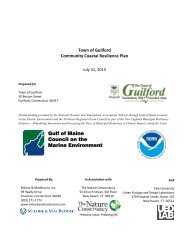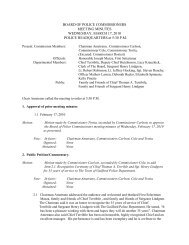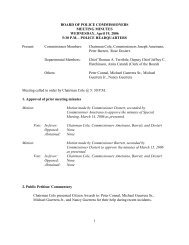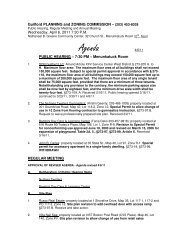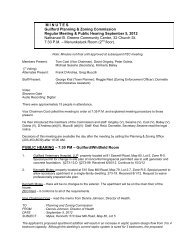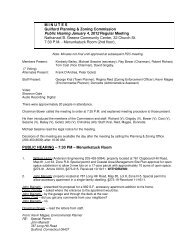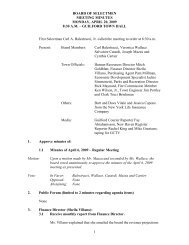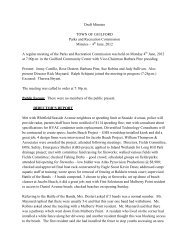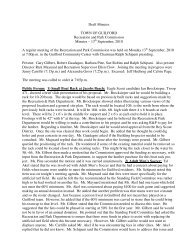Natural Resource Inventory and Assessment - Town of Guilford
Natural Resource Inventory and Assessment - Town of Guilford
Natural Resource Inventory and Assessment - Town of Guilford
You also want an ePaper? Increase the reach of your titles
YUMPU automatically turns print PDFs into web optimized ePapers that Google loves.
Upl<strong>and</strong>s<br />
D2<br />
Ground cover includes the low ferns, wildflowers, mosses, grasses, <strong>and</strong> sedges that cover the forest floor.<br />
Most are herbaceous, that is, not woody like shrubs or trees. Although not as conspicuous as the tree canopy,<br />
ground cover plays an important role in the forest. Flowers provide nectar for migratory pollinators, the low<br />
layer <strong>of</strong> vegetation provides cover for many creatures, <strong>and</strong> rotting leaves <strong>and</strong> logs break down to renew soil <strong>and</strong><br />
provide nutrients. <strong>Guilford</strong>’s forest floors reveal generations <strong>of</strong> trees that have died long ago. Shallow pits <strong>and</strong><br />
mounds indicate places where trees once fell, ripping up the roots <strong>and</strong> clinging soil. Eventually the roots<br />
decayed, leaving behind mounds <strong>of</strong> earth next to the depression.<br />
Forest Growth Stages: Forests vary in age, depending on when they last experienced a major<br />
disturbance such as a powerful storm, disease outbreak, or clearing for timber or agriculture. In addition to<br />
layers, a forest can be described as a series <strong>of</strong> growth stages. <strong>Guilford</strong>’s oldest forest st<strong>and</strong>s are found in places<br />
like ravines that were less accessible to clearing. Forest that grows after the first clearing is termed second<br />
growth; much <strong>of</strong> <strong>Guilford</strong> is comprised <strong>of</strong> third- <strong>and</strong> fourth-growth forest. Over time, forests develop <strong>and</strong><br />
accumulate several “legacy” features that enhance their health <strong>and</strong> contribute to biological diversity. These<br />
include the presence <strong>of</strong> fallen logs <strong>and</strong> rotting wood, a well-developed understory, complex structure, many <strong>of</strong><br />
which take hundreds <strong>of</strong> years to develop.<br />
All components <strong>of</strong> forest vegetation – living trees <strong>and</strong> shrubs, dead <strong>and</strong> downed trunks <strong>and</strong> limbs,<br />
st<strong>and</strong>ing snags (dead trees), micr<strong>of</strong>lora, lichens, mosses, <strong>and</strong> herbaceous plants –contribute to the diversity <strong>of</strong><br />
<strong>Guilford</strong>’s forests. In Connecticut tree cavities alone provide homes to treefrogs, 15 species <strong>of</strong> mammals, 20<br />
species <strong>of</strong> birds, <strong>and</strong> many insects.<br />
Like all <strong>of</strong> nature, <strong>Guilford</strong>’s forests are continually changing. Disturbance, which can cause rapid<br />
changes, includes weather events like winter storms, hurricanes, windthrow (wind-toppled trees), <strong>and</strong> drought,<br />
<strong>and</strong> logging, fire from lightning or human activity, <strong>and</strong> tree death from blights or pests like gypsy moth<br />
caterpillar <strong>and</strong> wooly adelgid). Disturbances <strong>of</strong>ten create opportunities for plants to establish themselves,<br />
because the soil has been exposed or sunny gaps have been created. In Westwoods, for example, beech <strong>and</strong><br />
black birch have colonized patches where hemlocks have died. Invasive species especially thrive in disturbed<br />
soil, <strong>and</strong> <strong>of</strong>ten can outcompete native plants after a disturbance (See Threats subsection below.)<br />
<strong>Guilford</strong>’s forests provide clues to past l<strong>and</strong> use. Miles <strong>of</strong> crisscrossing stone walls reveal the extent to<br />
which the l<strong>and</strong> was once cleared for farming, pasture, <strong>and</strong> charcoal. Thick-trunked, spreading trees in the<br />
middle <strong>of</strong> the forest (“wolf trees”) suggest trees that once stood alone in the open without crowding by<br />
adjacent trees. An excellent example st<strong>and</strong>s in Timberl<strong>and</strong>s at the intersection <strong>of</strong> the Red <strong>and</strong> Yellow Trails.<br />
Red cedars also serve as a clue that an area was once cleared (See Grassl<strong>and</strong>s section.)<br />
Although backyard woodlots have trees, they are not equivalent to intact forests. Forest edges are closer to<br />
human activities <strong>and</strong> so impacted by associated threats. For example, certain animals can survive only in the interior<br />
<strong>of</strong> large, intact forests, which are becoming increasingly rare in Connecticut, particularly in coastal towns such as<br />
<strong>Guilford</strong>. Some <strong>of</strong> them are vulnerable to predators (e.g., raccoons, skunks, blue jays, domestic cats) <strong>and</strong> nest<br />
parasites (e.g., cowbirds) that thrive in forest edges along clearings, but avoid deep forest. Others require large,<br />
unfragmented forests to hunt <strong>and</strong> disperse, like fisher <strong>and</strong> bobcat, or closed a canopy, like scarlet tanagers (because<br />
they hunt insects in the canopy) <strong>and</strong> worm-eating warblers (because they need unbroken stretches <strong>of</strong> forest).<br />
Forest Types: <strong>Guilford</strong> supports a variety <strong>of</strong> forest types, groups <strong>of</strong> plants <strong>and</strong> animals that tend to be<br />
found together <strong>and</strong> named after their dominant plants. Forest types concentrate in certain areas, depending<br />
on terrain, soil type, l<strong>and</strong>-use history, <strong>and</strong> other factors, <strong>and</strong> grade into each other across the l<strong>and</strong>scape. A<br />
description <strong>of</strong> each type follows.<br />
Oak/Hickory Forest<br />
<strong>Guilford</strong> is primarily comprised <strong>of</strong> oak/hickory forest. American chestnut dominated <strong>Guilford</strong> <strong>and</strong> the<br />
rest <strong>of</strong> southern New Engl<strong>and</strong>’s forests following the earliest cuttings by European settlers. When chestnuts<br />
were effectively eliminated by a fungal blight in the early 1900s (See Threats subsection), oaks <strong>and</strong> hickories<br />
replaced them in the canopy <strong>and</strong> today dominate the l<strong>and</strong>scape.<br />
<strong>Natural</strong> <strong>Resource</strong> <strong>Inventory</strong> <strong>and</strong> <strong>Assessment</strong> <strong>Town</strong> <strong>of</strong> <strong>Guilford</strong>, CT



